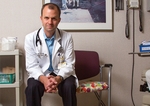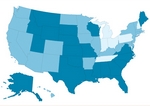profession
Tax breaks for residents to get Supreme Court review
■ A column analyzing the impact of recent court decisions on physicians
By Amy Lynn Sorrel — covered legal, antitrust, fraud and liability issues from 2005 to 2010, and has also written the "In the Courts" column. Posted Aug. 2, 2010.
- WITH THIS STORY:
- » External links
- » Related content
It's been said that death and taxes are inevitable. While physicians generally expect to fight the former in helping patients, some in the medical community are finding themselves unexpectedly battling both.
The U.S. Supreme Court in June accepted a case in which it will decide whether medical residents qualify as students for purposes of receiving an exemption from federal payroll taxes that fund Medicare and Social Security. At stake are billions of dollars that physicians and medical institutions say are best used to train the nation's next crop of doctors.
The dispute stems from amended regulations the Internal Revenue Service implemented in 2005, effectively barring residents, as well as the medical educational institutions sponsoring the doctors-in-training, from claiming the student tax exemption under the Federal Insurance Contributions Act.
The Treasury Dept. changed the regulations to clarify what it contended was confusion over the exemption by categorically excluding any employee who works 40 hours a week or more for a school, college or university from eligibility for the tax break, regardless of other educational components to their work.
Before the changes, federal law generally permitted a case-by-case evaluation of whether the student exception applied, based, for example, on certain criteria for a qualifying school and a program's curriculum, as well as the student's relationship to the employer. But the government has maintained that residents are primarily full-time workers.
The Mayo Foundation for Medical Education and Research and the University of Minnesota sued the federal government, claiming that the new regulations were invalid. The schools argued that the collective $2.8 million in stipends they paid to their residents were exempt from FICA taxes because the young doctors were predominantly students whose work was part of their training at the educational institutions. FICA taxes are imposed on both employers and employees, who typically split the tax contributions.
The suits were brought separately in the U.S. District Court for the District of Minnesota, which agreed with the medical institutions in 2007 and 2008. The government appealed to the 8th U.S. Circuit Court of Appeals, where the cases were combined. Appellate judges overturned the district court decisions in June 2009 and upheld the new IRS regulations.
Mayo and the University of Minnesota then petitioned the Supreme Court to resolve the issue. At this article's deadline, oral arguments in Mayo v. U.S. had not been scheduled.
With approximately 100,000 residents, dozens of medical schools and at least $700 million in annual taxes involved, the lawsuit is expected to have widespread ramifications.
"The question in this case involves billions of dollars in pending tax refund claims, and hundreds of millions of dollars per year in FICA taxes that must come from increasingly scarce medical education funds," University of Minnesota General Counsel Mark Rotenberg said in a statement.
In agreeing to hear the case, "the Supreme Court has acknowledged the exceptional importance of this question for medical residency programs and medical residents across the United States," Rotenberg said.
Mayo was not available for comment. The Justice Dept. and the IRS did not respond to interview requests.
Students or employees?
This is not the first time the issue has reached the courts.
In the late 1990s and early 2000s, the IRS held numerous refund claims filed by medical schools, teaching hospitals and residents, disputing the interpretation that they were eligible for the student exception. The move prompted several medical institutions to sue. In some cases, the government sued to recover what it argued were erroneous refunds. The various lawsuits resulted in mixed rulings at the district court level.
It was amid those cases that the government in 2004 put into motion the amended IRS regulations establishing a bright-line rule excluding students, including medical residents, who are full-time employees from qualifying for a FICA refund, among other standards. Meanwhile, several federal appellate courts overwhelmingly supported the medical community, finding that federal law did not make residents automatically ineligible for the student tax break.
In a 2007 decision, the 11th Circuit found that the federal statute underlying the student tax exception does not limit the types of services that qualify for the exemption, and if Congress intended to except residents, it could have done so explicitly. Three other circuits affirmed the ruling in 2008 and 2009. Although the courts did not directly address the new IRS regulations, they agreed that federal law required a case-by-case analysis of whether a medical resident is a "student" employed by a "school, college, or university," the nature of the residency program and the employer's status.
In the case of Mayo and the University of Minnesota, however, the 8th Circuit noted that the tax exemption statute was silent on residents. Judges found the recent IRS regulations to be consistent with the intent of the federal law, which was to allow part-time workers, not full-time employees, to benefit from the tax break.
The split between the 8th Circuit and the earlier rulings prompted the Supreme Court to take up the issue, legal experts said.
The government has maintained that residents are employees first and foremost, according to a brief the U.S. filed urging the high court to reject Mayo's appeal. Officials also argued that the government has the authority to clarify federal regulations.
But the medical and educational community says the government inappropriately changed the rules to skirt prior judicial precedents they argue should stand. That's according to a joint friend-of-the-court brief filed by the Assn. of American Medical Colleges, the American Council on Education and several other educational organizations, and a separate brief filed by Georgetown University and seven other universities, collectively representing hundreds of residency programs.
"Certainly, agencies do have the authority to change the rules. But they can't be what we call arbitrary and capricious, and these certainly seem to be very arbitrary," said Ivy S. Baer, director and regulatory counsel of health care affairs for the AAMC.
The IRS rules do not take into account how physicians are trained, she said. "The day you graduate medical school ... you can't just hang up a shingle and start practicing. There's a recognition that there is still a need for training."
Subjecting residents to additional taxes could reduce incentives for medical institutions to sponsor critical training at a time when the nation needs more doctors, the AAMC brief argued. And with young physicians facing increasing debt coming out of medical school, the added tax burden could push some doctors toward higher-paying specialties and away from lower-paying positions such as primary care, where the country's shortages are the worst, said Perry A. Pugno, MD, MPH, director of the American Academy of Family Physicians' division of medical education.
"The people [the new IRS rules are] going to affect are those the country needs the most now, and that's primary care," he said.
The average debt for medical students graduating in 2008 was $155,000, a 53% increase since 1998, according to a 2009 Government Accountability Office report. Once out of school, residents may earn stipends averaging about $45,000, the study said.
Whereas employment standards use a 40-hour workweek to set a typical employee's income, residents spend up to 80 hours meeting the rigorous educational and training standards of their sponsoring universities or teaching institutions, Dr. Pugno said. And the young doctors often must repay their loans while in training, which can take up a significant portion of their salary.
Residents "are primarily learners putting in lots and lots of hours, and one consequence of their learning behavior is providing services -- supervised services -- to patients. But the person responsible is generally the supervising professor or teacher, and the resident physician is there for the learning encounter," Dr. Pugno said.
The government apparently relented somewhat amid the ongoing litigation. The IRS in March made an administrative determination to accept the position that residents are excluded from FICA taxes for tax periods before April 1, 2005, the date the new regulations took effect.
But until the Supreme Court resolves the issue, the rules remain in play.
A win in the high court would not necessarily guarantee that all residents and residency programs would be exempt from having to pay FICA taxes, the AAMC's Baer said. But it would give them a chance to prove their eligibility.
Amy Lynn Sorrel covered legal, antitrust, fraud and liability issues from 2005 to 2010, and has also written the "In the Courts" column.












